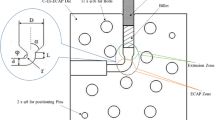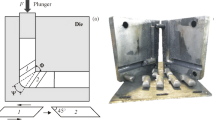Abstract
In this research, the ductile fracture of ultra-fine-grained copper was investigated. Ultra-fine-grained copper was produced using equal channel angular pressing process. During this process, the average grain size of the copper specimens decreases. Experiments have shown that stress state has significant effect on fracture behavior and should be included in the constitutive models. Therefore, the ductile failure was analyzed here by focusing on its relationship with the effect of hydrostatic pressure and Lode angle parameter. Tensile tests were performed on smooth and notched round bar specimens as well as doubly grooved samples. Moreover, the fracture surfaces were investigated by a scanning electron microscope. The experimental results reveal that the stress triaxiality and Lode angle parameter have a remarkable effect on the ductile fracture of the ECAPed specimens. However, the effect of stress triaxiality on ductility reduction is more significant than the effect of the Lode angle parameter. Also, the experimental results show the transition from the tensile ductile fracture to shear fracture in the ECAPed specimens.



















Similar content being viewed by others
References
M. Morales, E. Xuriguera, M. Martínez, J.A. Padilla, J. Molera, N. Ferrer, M. Segarra, and F. Espiell, Mechanical Characterization of Copper-Copper Wires Joined by Friction Welding Using Instrumented Indentation Technique, J. Mater. Eng. Perform., 2014, 23, p 3941–3948
M.J. Zehetbauer and R.Z. Valiev, Nanomaterials by Severe Plastic Deformation, Wiley, Hoboken, 2006, p 12–90
S. Khalilpourazary, M. Zadshakoyan, and S.H. Hoseini, Fatigue Life Improvement of Copper Processed by Equal Channel Angular Pressing, Exp. Technol. 2019, p 1–8
C. Wang, D. Song, J. Fan, and F. Li, Microstructure Evolution and Microhardness Distribution of Copper Processed Using Multiple Passes of Elliptical Cross-Sectional Spiral Equal-Channel Extrusion, J. Mater. Eng. Perform., 2018, 27, p 6665–6675
X. Wang, P. Li, and K. Xue, An Analysis on Microstructure and Grain Size of Molybdenum Powder Material Processed by Equal Channel Angular Pressing, J. Mater. Eng. Perform., 2015, 24, p 4510–4517
Y. Xiong, T. He, P. Li, L. Chen, F. Ren, and A.A. Volinsky, Microstructure and Mechanical Properties of Granular Pearlite Steel After Equal Channel Angular Pressing, J. Mater. Eng. Perform., 2015, 24, p 2665–2669
V.M. Segal, Materials Processing by Simple Shear, Mat. Sci. Eng. A-Struct., 1995, 197, p 157–164
R.Z. Valiev, E.V. Kozlov, Y.F. Ivanov, J. Lian, A.A. Nazarov, and B. Baudelet, Deformation Behavior of Ultra-Fine-Grained Copper, Acta Metall. Mater., 1994, 42, p 2467–2475
Y.J. Li, R. Kapoor, J.T. Wang, and W. Blum, Structural Stability of Ultrafine-Grained Copper, Scripta Mater., 2008, 58, p 53–56
H. Miyamoto, J. Fushimi, T. Mimaki, A. Vinogradov, and S. Hashimoto, The Effect of the Initial Orientation on Microstructure Development of Copper Single Crystals Subjected to Equal-Channel Angular Pressing, Mater. Sci. Forum, 2006, 503, p 799–804
L. Kommel, I. Hussainova, and O. Volobueva, Microstructure and Properties Development of Copper During Severe Plastic Deformation, Mater. Des., 2007, 28, p 2121–2128
R.J. Hellmig, M. Janecek, B. Hadzima, O.V. Gendelman, M. Shapiro, X. Molodova, A. Springer, and Y. Estrin, A Portrait of Copper Processed by Equal Channel Angular Pressing, Mater. Trans., 2008, 49, p 31–37
P.K. Jayakumar, K. Balasubramanian, and G.R. Tagore, Structure Property Correlation in Ultrafine Grained Copper Processed by Equal Channel Angular Processing, Eurasian Chemico-Technological J., 2011, 13, p 59–65
J.R. Groza, J.F. Shackelford, E.J. Lavernia, and M.T. Powers, Materials Processing Handbook, CRC Press, Boca Raton, 2007, p 1322–1323
X.X. Xu, F.L. Nie, J.X. Zhang, W. Zheng, Y.F. Zheng, C. Hu, and G. Yang, Corrosion and Ion Release Behavior of Ultra-Fine Grained Bulk Pure Copper Fabricated by ECAP in Hanks Solution as Potential Biomaterial for Contraception, Mater. Lett., 2010, 64, p 524–527
H. Marashi, D.M. Jafarlou, A.A. Sarahan, and N.A. Mardi, Employing Severe Plastic Deformation to the Processing of Electrical Discharge Machining Electrodes, Precis. Eng., 2016, 46, p 309–322
T. Ly, T. Thi, Equal Channel Angular Pessing (ECAP) Process of Copper Electrodes for Resistance Spot Brazing Application, Doctoral dissertation, Universiti Sains Malaysia, 2007
O. Irfan, S. Mukras, F. Al-Mufadi, and F. Djavanroodi, Surface Modeling of Nanostructured Copper Subjected to Erosion-Corrosion, Metals, 2017, 7, p 155
W.M. Garrison, Jr, and N.R. Moody, Ductile Fracture, J. Phys. Chem. Solids, 1987, 48, p 1035–1074
M. Besterci, K. Sülleiová, and T. Kvačkaj, Fracture Micromechanisms of Cu Nano-Materials Prepared by ECAP, Kovove Mater., 2008, 46, p 309–311
Y.G. Kim, B. Hwang, S. Lee, C.W. Lee, and D.H. Shin, Dynamic Deformation and Fracture Behavior of Ultra-Fine-Grained Pure Copper Fabricated by Equal Channel Angular Pressing, Mat. Sci. Eng. A., 2009, 504, p 163–168
P.W. Bridgman, Studies in Large Plastic Flow and Fracture, McGraw-Hill, New York, 1952, p 80–92
W. Hancock and A.C. Mackenzie, On the Mechanisms of Ductile Failure in High-Strength Steels Subjected to Multi-Axial Stress-States, J. Mech. Phys. Solids, 1976, 24, p 147–160
G. Le Roy, J.D. Embury, G. Edwards, and M.F. Ashby, A Model of Ductile Fracture Based on the Nucleation and Growth of Voids, Acta Metall., 1981, 29, p 1509–1522
G.R. Johnson and W.H. Cook, Fracture Characteristics of Three Metals Subjected to Various Strains, Strain Rates, Temperatures and Pressures, Eng. Fract. Mech., 1985, 21, p 31–48
Y. Bai and T. Wierzbicki, A New Model of Metal Plasticity and Fracture with Pressure and Lode Dependence, Int J Plasticity., 2008, 24, p 1071–1096
I. Barsoum and J. Faleskog, Rupture Mechanisms in Combined Tension and Shear Micromechanics, Int. J. Solids Struct., 2007, 44, p 1768–1786
I. Barsoum and J. Faleskog, Micromechanical Analysis on the Influence of the Lode Parameter on Void Growth and Coalescence, Int. J. Solids Struct., 2011, 48, p 925–938
M. Dunand and D. Mohr, Hybrid Experimental-Numerical Analysis of Basic Ductile Fracture Experiments for Sheet Metals, Int. J. Solids Struct., 2010, 47, p 1130–1143
Y. Bai and T. Wierzbicki, A Comparative Study of Three Groups of Ductile Fracture Loci in the 3D Space, Eng. Fract. Mech., 2015, 135, p 147–167
T. Sjöberg, S. Marth, J. Kajberg, and H.A. Häggblad, Experimental Characterisation of the Evolution of Triaxiality Stress State for Sheet Metal Materials, Eur. J. Mech. A-Solid., 2017, 66, p 279–286
C. Defaisse, M. Mazière, L. Marcin, and J. Besson, Ductile Fracture of an Ultra-High Strength Steel Under Low to Moderate Stress Triaxiality, Eng. Fract. Mech., 2018, 194, p 301–318
G. Mirone and D. Corallo, A Local Viewpoint for Evaluating the Influence of Stress Triaxiality and Lode Angle on Ductile Failure and Hardening, Int. J. Plasticity., 2010, 26, p 348–371
A.M. Beese and D. Mohr, Effect of Stress Triaxiality and Lode Angle on the Kinetics of Strain Induced Austenite to Martensite Transformation, Acta Mater., 2011, 59, p 2589–2600
Jr. C.M. Adams, Effective Ductility in Castings and Weldments, pp 179–97 of Ductility, American Society for Metals, Ohio (1968)
M. Goto, S.Z. Han, J. Kitamura, T. Yakushiji, J.H. Ahn, S.S. Kim, M. Baba, T. Yamamoto, and J. Lee, S-N Plots and Related Phenomena of Ultrafine Grained Copper with Different Stages of Microstructural Evolution, Int. J. Fatigue, 2015, 73, p 98–109
F. Dalla Torre, R. Lapovok, J. Sandlin, P.F. Thomson, C.H.J. Davies, and E.V. Pereloma, Microstructures and Properties of Copper Processed by Equal Channel Angular Extrusion for 1–16 Passes, Acta Mater., 2004, 52, p 4819–4832
D.A. Hughes and N. Hansen, Microstructure and Strength of Nickel at Large Strains, Acta Mater., 2000, 48, p 2985–3004
H.M. Westergaard, On the Resistance of Ductile Materials to Combined Stresses in Two or Three Directions Perpendicular to One Another, J. Franklin I., 1920, 189, p 627–640
L. Xue, Damage Accumulation and Fracture Initiation in Uncracked Ductile Solids Subject to Triaxial Loading, Int. J. Solids Struct., 2007, 44, p 5163–5181
ASTM BS EN 15079, Copper and copper alloys: Analysis by spark optical emission spectrometry (S-OES), BSI Standards Publications (2015)
M. Furukawa, Y. Iwahashi, Z. Horita, M. Nemoto, and T.G. Langdon, The Shearing Characteristics Associated with Equal-Channel Angular Pressing, Mater. Sci. Eng. A-Struct., 1998, 257, p 328–332
ASTM E92-82, Standard Test Method for Vickers Hardness of Metallic Materials, ASTM International (2003)
L.R. Saitova, H.W. Höppel, M. Göken, I.P. Semenova, G.I. Raab, and R.Z. Valiev, Fatigue Behavior of Ultrafine-Grained Ti–6Al–4 V ‘ELI’alloy for Medical Applications, Mater. Sci. Eng., A, 2009, 503, p 145–147
ASTM E8, Standard Test Methods for Tension Testing of Metallic Materials, ASTM International (2004)
J. Xu, J. Li, D. Shan, and B. Guo, Strain Softening Mechanism at Meso Scale During micro-compression in an Ultrafine-Grained Pure Copper, AIP Adv., 2015, 5, p 097147
A. Mishra, B.K. Kad, F. Gregori, and M.A. Meyers, Microstructural Evolution in Copper Subjected to Severe Plastic Deformation: Experiments and Analysis, Acta Mater., 2007, 55, p 13–28
E.P. Degarmo, J.T. Black, and R.A. Kosher, Materials and Processes in Manufacturing, Wiley, Hoboken, 2003
J.R. Davis, ASM Specialty Handbook: Copper and Copper Alloys, ASM International, Ohio, 2001
K. Mills, Fractography, ASM International, West Conshohocken, 1987, p 12–22
Author information
Authors and Affiliations
Corresponding author
Additional information
Publisher's Note
Springer Nature remains neutral with regard to jurisdictional claims in published maps and institutional affiliations.
Rights and permissions
About this article
Cite this article
Hoseini, S.H., Khalilpourazary, S. & Zadshakoyan, M. Fracture Behavior of Annealed and Equal Channel Angular Pressed Copper: An Experimental Study. J. of Materi Eng and Perform 29, 975–986 (2020). https://doi.org/10.1007/s11665-020-04598-z
Received:
Revised:
Published:
Issue Date:
DOI: https://doi.org/10.1007/s11665-020-04598-z




